Knee Joint Contact Forces during High-Risk Dynamic Tasks: 90° Change of Direction and Deceleration Movements
Abstract
1. Introduction
2. Materials and Methods
2.1. Participants
2.2. Data Collection
2.3. Data Processing
2.4. Musculoskeletal Modeling
2.5. Statistical Analysis
3. Results
3.1. Change in TFCF According to Varus–Valgus Angle Correction
3.2. Neutral vs. Aligned Models of TFCF
3.3. Medial vs. Lateral Compartment TFCF
3.4. Male vs. Female TFCF
3.5. Varus–Valgus Genu
4. Discussion
5. Conclusions
Supplementary Materials
Author Contributions
Funding
Institutional Review Board Statement
Informed Consent Statement
Data Availability Statement
Acknowledgments
Conflicts of Interest
References
- Paffenbarger, R.S.J.; Kampert, J.B.; Lee, I.-M.; Hyde, R.T.; Leung, R.W.; Wing, A.L. Changes in physical activity and other lifeway patterns influencing longevity. Med. Sci. Sport. Exerc. 1994, 26, 857. [Google Scholar] [CrossRef]
- Booth, F.W.; Roberts, C.K.; Laye, M.J. Lack of exercise is a major cause of chronic diseases. Compr. Physiol. 2012, 2, 1143–1211. [Google Scholar] [CrossRef] [PubMed]
- Jebb, S.A.; Moore, M.S. Contribution of a sedentary lifestyle and inactivity to the etiology of overweight and obesity: Current evidence and research issues. Med. Sci. Sport. Exerc. 1999, 31, S534. [Google Scholar] [CrossRef]
- Blazek, A.D.; Nam, J.; Gupta, R.; Pradhan, M.; Perera, P.; Weisleder, N.L.; Hewett, T.E.; Chaudhari, A.M.; Lee, B.S.; Leblebicioglu, B.; et al. Exercise-Driven Metabolic Pathways in Healthy Cartilage. Osteoarthr. Cartil. 2016, 24, 1210–1222. [Google Scholar] [CrossRef]
- Emery, C.A.; Pasanen, K. Current trends in sport injury prevention. Best Pract. Res. Clin. Rheumatol. 2019, 33, 3–15. [Google Scholar] [CrossRef]
- Eime, R.M.; Young, J.A.; Harvey, J.T.; Charity, M.J.; Payne, W.R. A systematic review of the psychological and social benefits of participation in sport for children and adolescents: Informing development of a conceptual model of health through sport. Int. J. Behav. Nutr. Phys. Act. 2013, 10, 98. [Google Scholar] [CrossRef] [PubMed]
- Prieto-González, P.; Martínez-Castillo, J.L.; Fernández-Galván, L.M.; Casado, A.; Soporki, S.; Sánchez-Infante, J. Epidemiology of Sports-Related Injuries and Associated Risk Factors in Adolescent Athletes: An Injury Surveillance. Int. J. Environ. Res. Public Health 2021, 18, 4857. [Google Scholar] [CrossRef]
- Vignon, É.; Valat, J.-P.; Rossignol, M.; Avouac, B.; Rozenberg, S.; Thoumie, P.; Avouac, J.; Nordin, M.; Hilliquin, P. Osteoarthritis of the knee and hip and activity: A systematic international review and synthesis (OASIS). Jt. Bone Spine 2006, 73, 442–455. [Google Scholar] [CrossRef]
- Mithoefer, K.; Peterson, L.; Zenobi-Wong, M.; Mandelbaum, B.R. Cartilage issues in football—today’s problems and tomorrow’s solutions. Br. J. Sports Med. 2015, 49, 590–596. [Google Scholar] [CrossRef]
- Brophy, R.H.; Rodeo, S.A.; Barnes, R.P.; Powell, J.W.; Warren, R.F. Knee articular cartilage injuries in the National Football League: Epidemiology and treatment approach by team physicians. J. Knee Surg. 2009, 22, 331–338. [Google Scholar] [CrossRef]
- Whittaker, J.L.; Runhaar, J.; Bierma-Zeinstra, S.; Roos, E.M. A lifespan approach to osteoarthritis prevention. Osteoarthr. Cartil. 2021, 29, 1638–1653. [Google Scholar] [CrossRef] [PubMed]
- Driban, J.B.; Hootman, J.M.; Sitler, M.R.; Harris, K.P.; Cattano, N.M. Is Participation in Certain Sports Associated With Knee Osteoarthritis? A Systematic Review. J. Athl. Train. 2017, 52, 497–506. [Google Scholar] [CrossRef] [PubMed]
- Brown, S.R.; Brughelli, M.; Hume, P.A. Knee mechanics during planned and unplanned sidestepping: A systematic review and meta-analysis. Sports Med. 2014, 44, 1573–1588. [Google Scholar] [CrossRef]
- Shin, C.S.; Chaudhari, A.M.; Andriacchi, T.P. The influence of deceleration forces on ACL strain during single-leg landing: A simulation study. J. Biomech. 2007, 40, 1145–1152. [Google Scholar] [CrossRef] [PubMed]
- Lin, C.; Casey, E.; Herman, D.; Katz, N.; Tenforde, A. Sex Differences in Common Sports Injuries. PM&R 2018, 10, 1073–1082. [Google Scholar] [CrossRef]
- Markolf, K.; Yamaguchi, K.; Matthew, J.; McAllister, D. Effects of tibiofemoral compression on ACL forces and knee kinematics under combined knee loads. J. Orthop. Res. 2019, 37, 631–639. [Google Scholar] [CrossRef] [PubMed]
- Alentorn-Geli, E.; Myer, G.D.; Silvers, H.J.; Samitier, G.; Romero, D.; Lázaro-Haro, C.; Cugat, R. Prevention of non-contact anterior cruciate ligament injuries in soccer players. Part 1: Mechanisms of injury and underlying risk factors. Knee Surg. Sport. Traumatol. Arthrosc. 2009, 17, 705–729. [Google Scholar] [CrossRef] [PubMed]
- King, E.; Richter, C.; Daniels, K.A.J.; Franklyn-Miller, A.; Falvey, E.; Myer, G.D.; Jackson, M.; Moran, R.; Strike, S. Can Biomechanical Testing After Anterior Cruciate Ligament Reconstruction Identify Athletes at Risk for Subsequent ACL Injury to the Contralateral Uninjured Limb? Am. J. Sports Med. 2021, 49, 609–619. [Google Scholar] [CrossRef]
- Di Paolo, S.; Bragonzoni, L.; Della Villa, F.; Grassi, A.; Zaffagnini, S. Do healthy athletes exhibit at-risk biomechanics for anterior cruciate ligament injury during pivoting movements? Sports Biomech. 2022, 1–14. [Google Scholar] [CrossRef]
- Lloyd, D. The future of in-field sports biomechanics: Wearables plus modelling compute real-time in vivo tissue loading to prevent and repair musculoskeletal injuries. Sports Biomech. 2021, 1–29. [Google Scholar] [CrossRef]
- Saxby, D.J.; Modenese, L.; Bryant, A.L.; Gerus, P.; Killen, B.; Fortin, K.; Wrigley, T.V.; Bennell, K.L.; Cicuttini, F.M.; Lloyd, D.G. Tibiofemoral contact forces during walking, running and sidestepping. Gait Posture 2016, 49, 78–85. [Google Scholar] [CrossRef] [PubMed]
- Willy, R.W.; Meardon, S.A.; Schmidt, A.; Blaylock, N.R.; Hadding, S.A.; Willson, J.D. Changes in tibiofemoral contact forces during running in response to in-field gait retraining. J. Sports Sci. 2016, 34, 1602–1611. [Google Scholar] [CrossRef] [PubMed]
- Thakkar, B.; Willson, J.D.; Harrison, K.; Tickes, R.; Blaise Williams, D.S.I. Tibiofemoral Joint Forces in Female Recreational Runners Vary with Step Frequency. Med. Sci. Sport. Exerc. 2019, 51, 1444. [Google Scholar] [CrossRef]
- Cleather, D.J.; Goodwin, J.E.; Bull, A.M. Hip and knee joint loading during vertical jumping and push jerking. Clin. Biomech. 2013, 28, 98–103. [Google Scholar] [CrossRef] [PubMed]
- Tsai, L.-C.; Ko, Y.-A.; Hammond, K.; Xerogeanes, J.; Warren, G.; Powers, C. Increasing hip and knee flexion during a drop-jump task reduces tibiofemoral shear and compressive forces: Implications for ACL injury prevention training. J. Sport. Sci. 2016, 35, 2405–2411. [Google Scholar] [CrossRef] [PubMed]
- Saxby, D.J.; Bryant, A.L.; Modenese, L.; Gerus, P.; Killen, B.A.; Konrath, J.; Fortin, K.; Wrigley, T.V.; Bennell, K.L.; Cicuttini, F.M.; et al. Tibiofemoral Contact Forces in the Anterior Cruciate Ligament–Reconstructed Knee. Med. Sci. Sport. Exerc. 2016, 48, 2195–2206. [Google Scholar] [CrossRef]
- Maniar, N.; Bryant, A.L.; Sritharan, P.; Schache, A.G.; Opar, D.A. Muscle contributions to medial and lateral tibiofemoral compressive loads during sidestep cutting. J. Biomech. 2020, 101, 109641. [Google Scholar] [CrossRef]
- Killen, B.A.; Saxby, D.J.; Fortin, K.; Gardiner, B.S.; Wrigley, T.V.; Bryant, A.L.; Lloyd, D.G. Individual muscle contributions to tibiofemoral compressive articular loading during walking, running and sidestepping. J. Biomech. 2018, 80, 23–31. [Google Scholar] [CrossRef]
- Kutzner, I.; Bender, A.; Dymke, J.; Duda, G.; von Roth, P.; Bergmann, G. Mediolateral force distribution at the knee joint shifts across activities and is driven by tibiofemoral alignment. Bone Jt. J. 2017, 99-B, 779–787. [Google Scholar] [CrossRef]
- Lerner, Z.F.; DeMers, M.S.; Delp, S.L.; Browning, R.C. How tibiofemoral alignment and contact locations affect predictions of medial and lateral tibiofemoral contact forces. J. Biomech. 2015, 48, 644–650. [Google Scholar] [CrossRef]
- Lerner, Z.F.; Browning, R.C. Compressive and shear hip joint contact forces are affected by pediatric obesity during walking. J. Biomech. 2016, 49, 1547–1553. [Google Scholar] [CrossRef]
- Delp, S.L.; Anderson, F.C.; Arnold, A.S.; Loan, P.; Habib, A.; John, C.T.; Guendelman, E.; Thelen, D.G. OpenSim: Open-source software to create and analyze dynamic simulations of movement. IEEE Trans. Biomed. Eng. 2007, 54, 1940–1950. [Google Scholar] [CrossRef] [PubMed]
- DeMers, M.S.; Pal, S.; Delp, S.L. Changes in Tibiofemoral Forces due to Variations in Muscle Activity during Walking. J. Orthop. Res. 2014, 32, 769–776. [Google Scholar] [CrossRef] [PubMed]
- Rajagopal, A.; Dembia, C.L.; DeMers, M.S.; Delp, D.D.; Hicks, J.L.; Delp, S.L. Full-Body Musculoskeletal Model for Muscle-Driven Simulation of Human Gait. IEEE Trans. Biomed. Eng. 2016, 63, 2068–2079. [Google Scholar] [CrossRef]
- Lai, A.K.M.; Arnold, A.S.; Wakeling, J.M. Why are antagonist muscles co-activated in my simulation? A musculoskeletal model for analysing human locomotor tasks. Ann. Biomed. Eng. 2017, 45, 2762–2774. [Google Scholar] [CrossRef]
- Di Paolo, S.; Lopomo, N.F.; Della Villa, F.; Paolini, G.; Figari, G.; Bragonzoni, L.; Grassi, A.; Zaffagnini, S. Rehabilitation and Return to Sport Assessment after Anterior Cruciate Ligament Injury: Quantifying Joint Kinematics during Complex High-Speed Tasks through Wearable Sensors. Sensors 2021, 21, 2331. [Google Scholar] [CrossRef] [PubMed]
- Della Villa, F.; Di Paolo, S.; Santagati, D.; Della Croce, E.; Lopomo, N.F.; Grassi, A.; Zaffagnini, S. A 2D video-analysis scoring system of 90° change of direction technique identifies football players with high knee abduction moment. Knee Surg. Sports Traumatol. Arthrosc. 2021, 30, 3616–3625. [Google Scholar] [CrossRef]
- Di Paolo, S.; Zaffagnini, S.; Tosarelli, F.; Aggio, F.; Bragonzoni, L.; Grassi, A.; Della Villa, F. A 2D qualitative movement assessment of a deceleration task detects football players with high knee joint loading. Knee Surg. Sports Traumatol. Arthrosc. 2021, 29, 4032–4040. [Google Scholar] [CrossRef]
- Walker, P.S.; Rovick, J.S.; Robertson, D.D. The effects of knee brace hinge design and placement on joint mechanics. J. Biomech. 1988, 21, 965–974. [Google Scholar] [CrossRef]
- Nichols, T.E.; Holmes, A.P. Nonparametric permutation tests for functional neuroimaging: A primer with examples. Hum. Brain Mapp. 2002, 15, 1–25. [Google Scholar] [CrossRef]
- Pataky, T.C.; Robinson, M.A.; Vanrenterghem, J. Vector field statistical analysis of kinematic and force trajectories. J. Biomech. 2013, 46, 2394–2401. [Google Scholar] [CrossRef]
- Wesseling, M.; Meyer, C.; Corten, K.; Desloovere, K.; Jonkers, I. Longitudinal joint loading in patients before and up to one year after unilateral total hip arthroplasty. Gait Posture 2018, 61, 117–124. [Google Scholar] [CrossRef]
- Lucarno, S.; Zago, M.; Buckthorpe, M.; Grassi, A.; Tosarelli, F.; Smith, R.; Della Villa, F. Systematic Video Analysis of Anterior Cruciate Ligament Injuries in Professional Female Soccer Players. Am. J. Sports Med. 2021, 49, 1794–1802. [Google Scholar] [CrossRef] [PubMed]
- Della Villa, F.; Buckthorpe, M.; Grassi, A.; Nabiuzzi, A.; Tosarelli, F.; Zaffagnini, S.; Della Villa, S. Systematic video analysis of ACL injuries in professional male football (soccer): Injury mechanisms, situational patterns and biomechanics study on 134 consecutive cases. Br. J. Sports Med. 2020, 54, 1423–1432. [Google Scholar] [CrossRef] [PubMed]
- Della Villa, F.; Tosarelli, F.; Ferrari, R.; Grassi, A.; Ciampone, L.; Nanni, G.; Zaffagnini, S.; Buckthorpe, M. Systematic Video Analysis of Anterior Cruciate Ligament Injuries in Professional Male Rugby Players: Pattern, Injury Mechanism, and Biomechanics in 57 Consecutive Cases. Orthop. J. Sport. Med. 2021, 9, 23259671211048184. [Google Scholar] [CrossRef] [PubMed]
- Weinhandl, J.T.; Earl-Boehm, J.E.; Ebersole, K.T.; Huddleston, W.E.; Armstrong, B.S.R.; O’Connor, K.M. Reduced hamstring strength increases anterior cruciate ligament loading during anticipated sidestep cutting. Clin. Biomech. 2014, 29, 752–759. [Google Scholar] [CrossRef] [PubMed]
- Schipplein, O.D.; Andriacchi, T.P. Interaction between active and passive knee stabilizers during level walking. J. Orthop. Res. 1991, 9, 113–119. [Google Scholar] [CrossRef] [PubMed]
- Besier, T.F.; Lloyd, D.G.; Ackland, T.R. Muscle activation strategies at the knee during running and cutting maneuvers. Med. Sci. Sports Exerc. 2003, 35, 119–127. [Google Scholar] [CrossRef]
- Rooney, B.D.; Derrick, T.R. Joint contact loading in forefoot and rearfoot strike patterns during running. J. Biomech. 2013, 46, 2201–2206. [Google Scholar] [CrossRef] [PubMed]
- Saxby, D.J.; Bryant, A.L.; Wang, X.; Modenese, L.; Gerus, P.; Konrath, J.M.; Bennell, K.L.; Fortin, K.; Wrigley, T.; Cicuttini, F.M.; et al. Relationships Between Tibiofemoral Contact Forces and Cartilage Morphology at 2 to 3 Years After Single-Bundle Hamstring Anterior Cruciate Ligament Reconstruction and in Healthy Knees. Orthop. J. Sports Med. 2017, 5, 2325967117722506. [Google Scholar] [CrossRef]
- Sharma, L.; Song, J.; Felson, D.T.; Cahue, S.; Shamiyeh, E.; Dunlop, D.D. The role of knee alignment in disease progression and functional decline in knee osteoarthritis. JAMA 2001, 286, 188–195. [Google Scholar] [CrossRef] [PubMed]
- Barrios, J.A.; Crossley, K.M.; Davis, I.S. Gait Retraining to Reduce the Knee Adduction Moment Through Real-Time Visual Feedback of Dynamic Knee Alignment. J. Biomech. 2010, 43, 2208–2213. [Google Scholar] [CrossRef] [PubMed]
- Merritt, A.; Roemer, F.W.; Heiss, R.; Jarraya, M.; Guermazi, D.; Hayashi, D.; Engebretsen, L.; Crema, M.D.; Guermazi, A. Frequency of MRI-detected peripheral osteoarthritis in athletes during the Summer Olympics in Rio 2016. Osteoarthr. Cartil. Open 2021, 3, 100199. [Google Scholar] [CrossRef]
- Smith, H.C.; Vacek, P.; Johnson, R.J.; Slauterbeck, J.R.; Hashemi, J.; Shultz, S.; Beynnon, B.D. Risk Factors for Anterior Cruciate Ligament Injury. Sports Health 2012, 4, 69–78. [Google Scholar] [CrossRef]
- Yang, N.H.; Nayeb-Hashemi, H.; Canavan, P.K.; Vaziri, A. Effect of frontal plane tibiofemoral angle on the stress and strain at the knee cartilage during the stance phase of gait. J. Orthop. Res. 2010, 28, 1539–1547. [Google Scholar] [CrossRef] [PubMed]
- Dempsey, A.R.; Lloyd, D.G.; Elliott, B.C.; Steele, J.R.; Munro, B.J. Changing Sidestep Cutting Technique Reduces Knee Valgus Loading. Am. J. Sports Med. 2009, 37, 2194–2200. [Google Scholar] [CrossRef]
- Gerus, P.; Sartori, M.; Besier, T.F.; Fregly, B.J.; Delp, S.L.; Banks, S.A.; Pandy, M.G.; D’Lima, D.D.; Lloyd, D.G. Subject-specific knee joint geometry improves predictions of medial tibiofemoral contact forces. J. Biomech. 2013, 46, 2778–2786. [Google Scholar] [CrossRef]
- Martelli, S.; Sancisi, N.; Conconi, M.; Pandy, M.G.; Kersh, M.E.; Parenti-Castelli, V.; Reynolds, K.J. The relationship between tibiofemoral geometry and musculoskeletal function during normal activity. Gait Posture 2020, 80, 374–382. [Google Scholar] [CrossRef]
- Konrath, J.M.; Karatsidis, A.; Schepers, H.M.; Bellusci, G.; de Zee, M.; Andersen, M.S. Estimation of the Knee Adduction Moment and Joint Contact Force during Daily Living Activities Using Inertial Motion Capture. Sensors 2019, 19, 1681. [Google Scholar] [CrossRef]
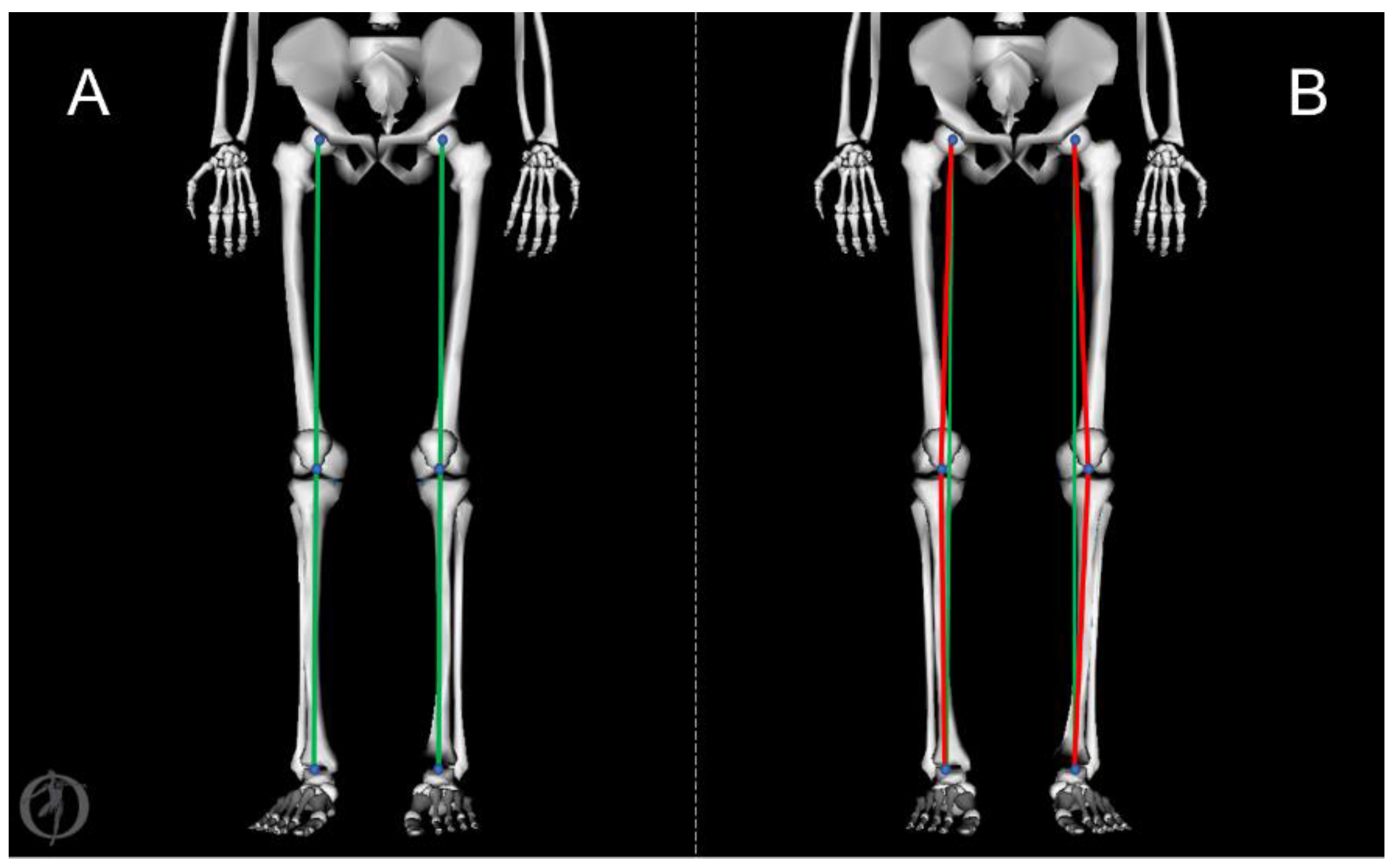



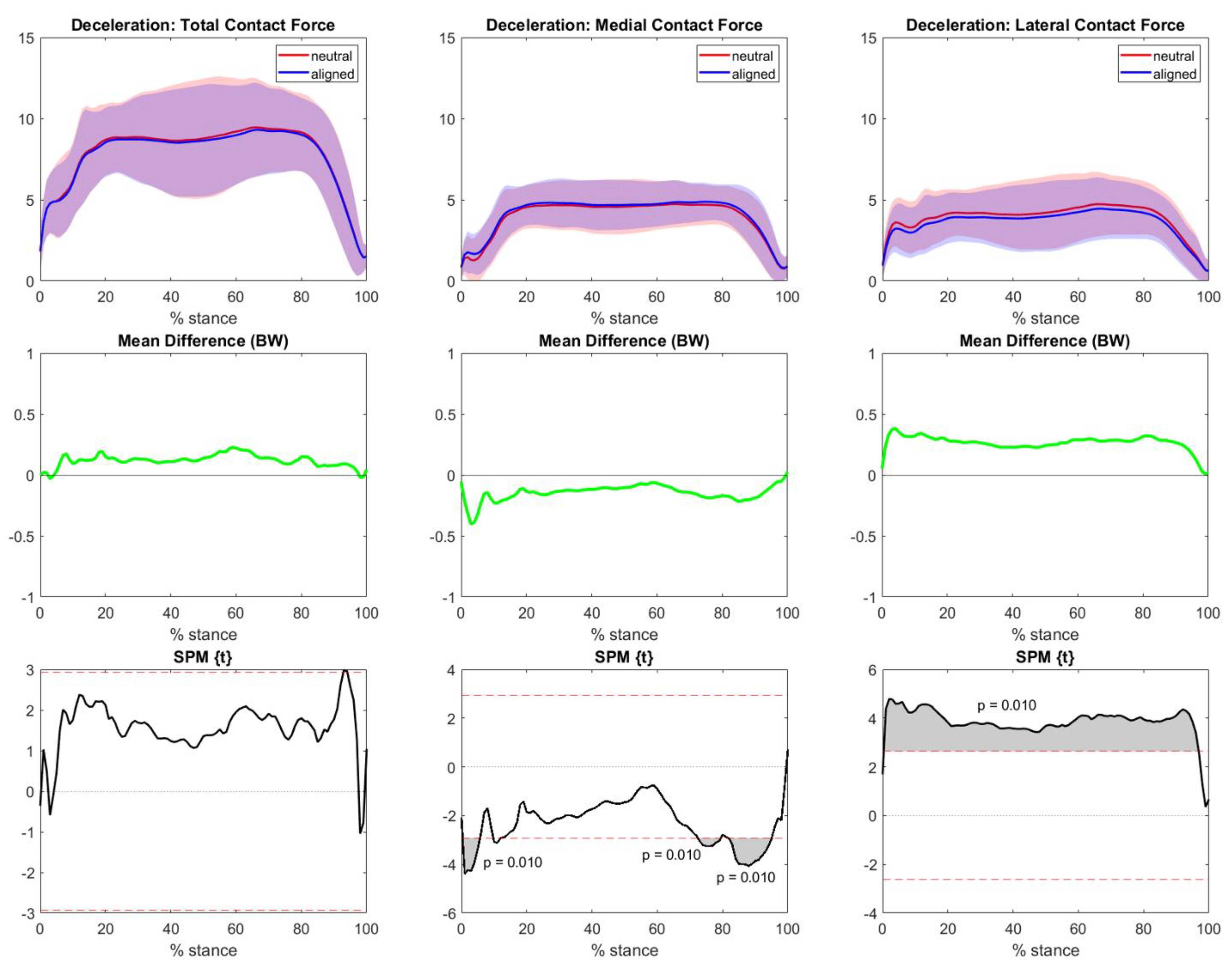
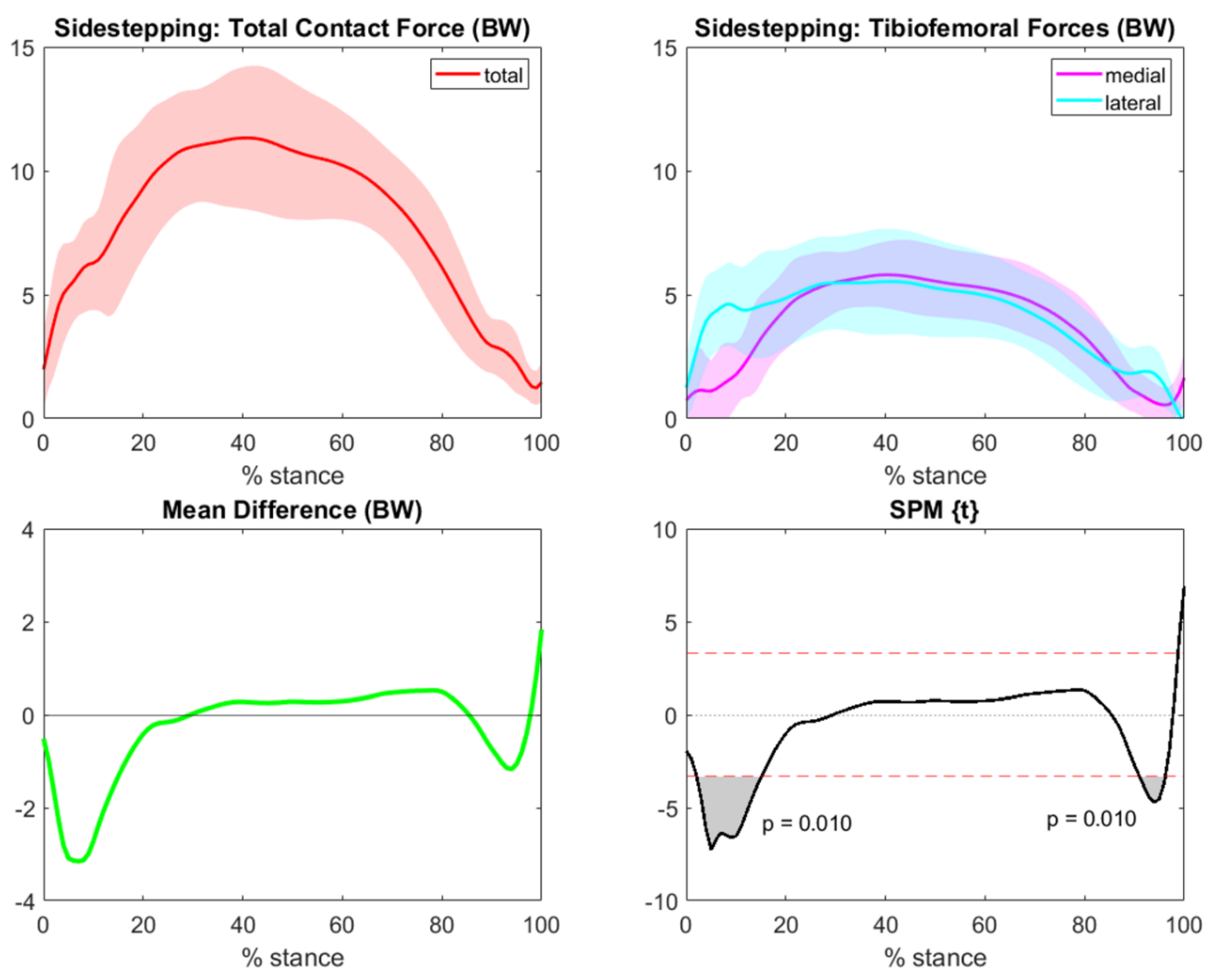
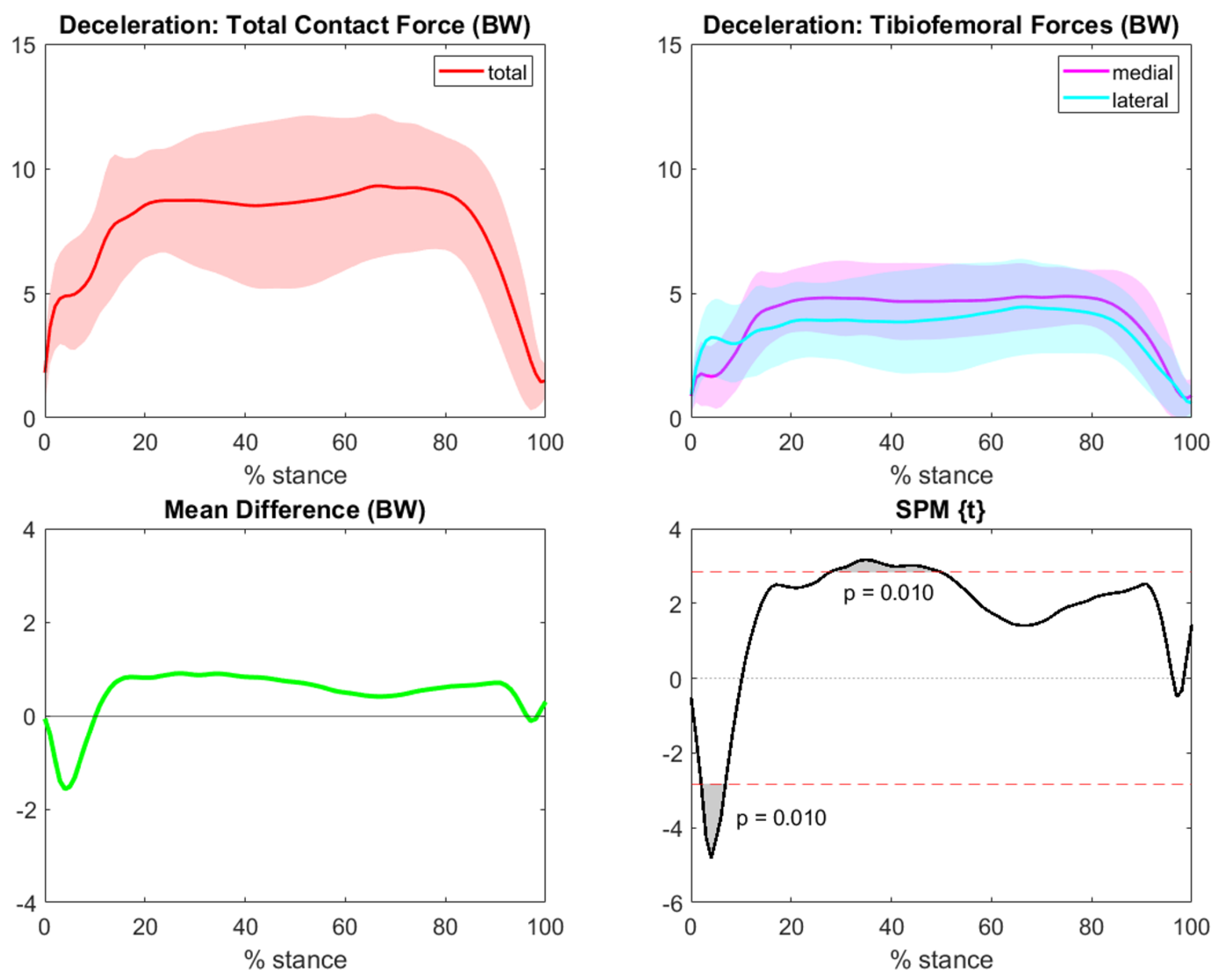
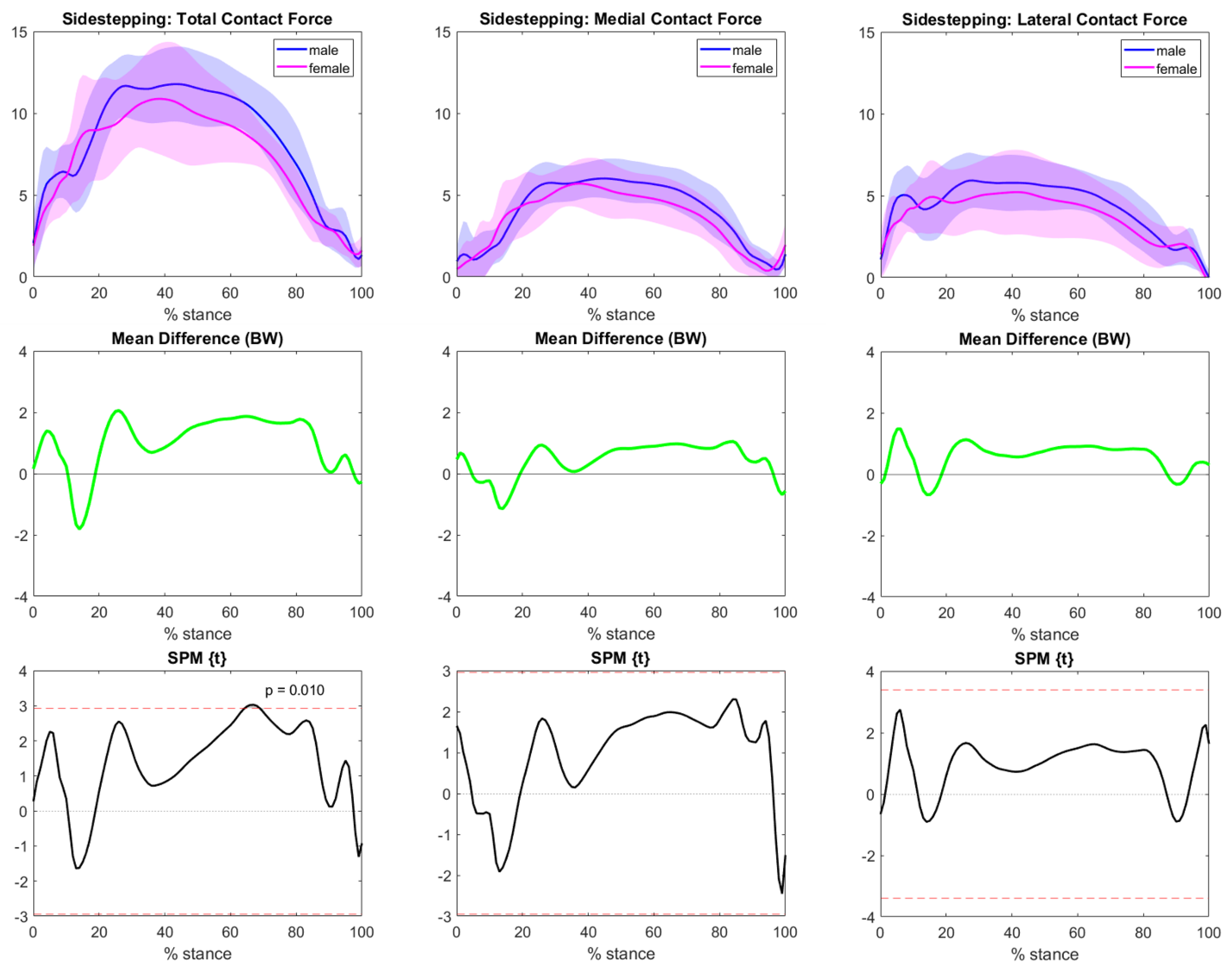

| Total | Male | Female | Varus | Valgus | |
|---|---|---|---|---|---|
| Numerosity | 31 | 17 | 14 | 24 | 7 |
| Sex (m/f) | 17/14 | 17/0 | 0/14 | 12/12 | 5/2 |
| Age (y) | 23.1 ± 4.1 | 24.2 ± 3.5 | 21.8 ± 4.4 | 23.5 ± 4.2 | 21.6 ± 3.7 |
| Body Mass (kg) | 70.0 ± 13.9 | 79.9 ± 11.0 + | 57.9 ± 3.5 + | 69.0 ± 14.8 | 73.4 ± 10.3 |
| Height (cm) | 175.4 ± 10.0 | 181.9 ± 7.0 + | 167.5 ± 6.8 + | 174.3 ± 10.2 | 179.0 ± 8.8 |
| BMI (kg/m2) | 22.55 ± 2.62 | 24.1 ± 2.43 + | 20.68 ± 1.28 + | 22.45 ± 2.63 | 22.91 ± 2.72 |
| Knee Alignment (°) | 2.03 ± 2.68 | 2.21 ± 2.9 | 1.8 ± 2.48 | 3.09 ± 1.88 # | −1.63 ± 1.52 # |
| 90° COD | DEC | |||||
|---|---|---|---|---|---|---|
| Parameter | Total | Medial | Lateral | Total | Medial | Lateral |
| Peak TFCF (BW) | ||||||
| All | 12.81 ± 2.17 | 6.73 ± 1.24 | 6.74 ± 1.68 | 11.54 ± 2.59 | 6.23 ± 1.2 | 5.63 ± 1.66 |
| Male | 13.02 ± 1.67 | 6.9 ± 1.03 | 6.87 ± 1.48 | 11.97 ± 2.3 | 6.5 ± 1.16 | 5.84 ± 1.3 |
| Female | 12.54 ± 2.69 | 6.51 ± 1.48 | 6.58 ± 1.94 | 11.02 ± 2.92 | 5.91 ± 1.21 | 5.37 ± 2.04 |
| Average TFCF (BW) | ||||||
| All | 7.89 ± 1.33 | 3.8 ± 0.76 | 4.09 ± 1.23 | 7.6 ± 1.7 | 4.07 ± 0.82 | 3.59 ± 1.28 |
| Male | 8.35 ± 1.08 | 4 ± 0.59 | 4.35 ± 1.05 | 7.97 ± 1.6 | 4.29 ± 0.82 | 3.68 ± 1.21 |
| Female | 7.34 ± 1.44 | 3.56 ± 0.88 | 3.77 ± 1.39 | 7.28 ± 1.79 | 3.8 ± 0.76 | 3.48 ± 1.41 |
Disclaimer/Publisher’s Note: The statements, opinions and data contained in all publications are solely those of the individual author(s) and contributor(s) and not of MDPI and/or the editor(s). MDPI and/or the editor(s) disclaim responsibility for any injury to people or property resulting from any ideas, methods, instructions or products referred to in the content. |
© 2023 by the authors. Licensee MDPI, Basel, Switzerland. This article is an open access article distributed under the terms and conditions of the Creative Commons Attribution (CC BY) license (https://creativecommons.org/licenses/by/4.0/).
Share and Cite
Cassiolas, G.; Di Paolo, S.; Marchiori, G.; Grassi, A.; Della Villa, F.; Bragonzoni, L.; Visani, A.; Giavaresi, G.; Fini, M.; Zaffagnini, S.; et al. Knee Joint Contact Forces during High-Risk Dynamic Tasks: 90° Change of Direction and Deceleration Movements. Bioengineering 2023, 10, 179. https://doi.org/10.3390/bioengineering10020179
Cassiolas G, Di Paolo S, Marchiori G, Grassi A, Della Villa F, Bragonzoni L, Visani A, Giavaresi G, Fini M, Zaffagnini S, et al. Knee Joint Contact Forces during High-Risk Dynamic Tasks: 90° Change of Direction and Deceleration Movements. Bioengineering. 2023; 10(2):179. https://doi.org/10.3390/bioengineering10020179
Chicago/Turabian StyleCassiolas, Giorgio, Stefano Di Paolo, Gregorio Marchiori, Alberto Grassi, Francesco Della Villa, Laura Bragonzoni, Andrea Visani, Gianluca Giavaresi, Milena Fini, Stefano Zaffagnini, and et al. 2023. "Knee Joint Contact Forces during High-Risk Dynamic Tasks: 90° Change of Direction and Deceleration Movements" Bioengineering 10, no. 2: 179. https://doi.org/10.3390/bioengineering10020179
APA StyleCassiolas, G., Di Paolo, S., Marchiori, G., Grassi, A., Della Villa, F., Bragonzoni, L., Visani, A., Giavaresi, G., Fini, M., Zaffagnini, S., & Lopomo, N. F. (2023). Knee Joint Contact Forces during High-Risk Dynamic Tasks: 90° Change of Direction and Deceleration Movements. Bioengineering, 10(2), 179. https://doi.org/10.3390/bioengineering10020179












